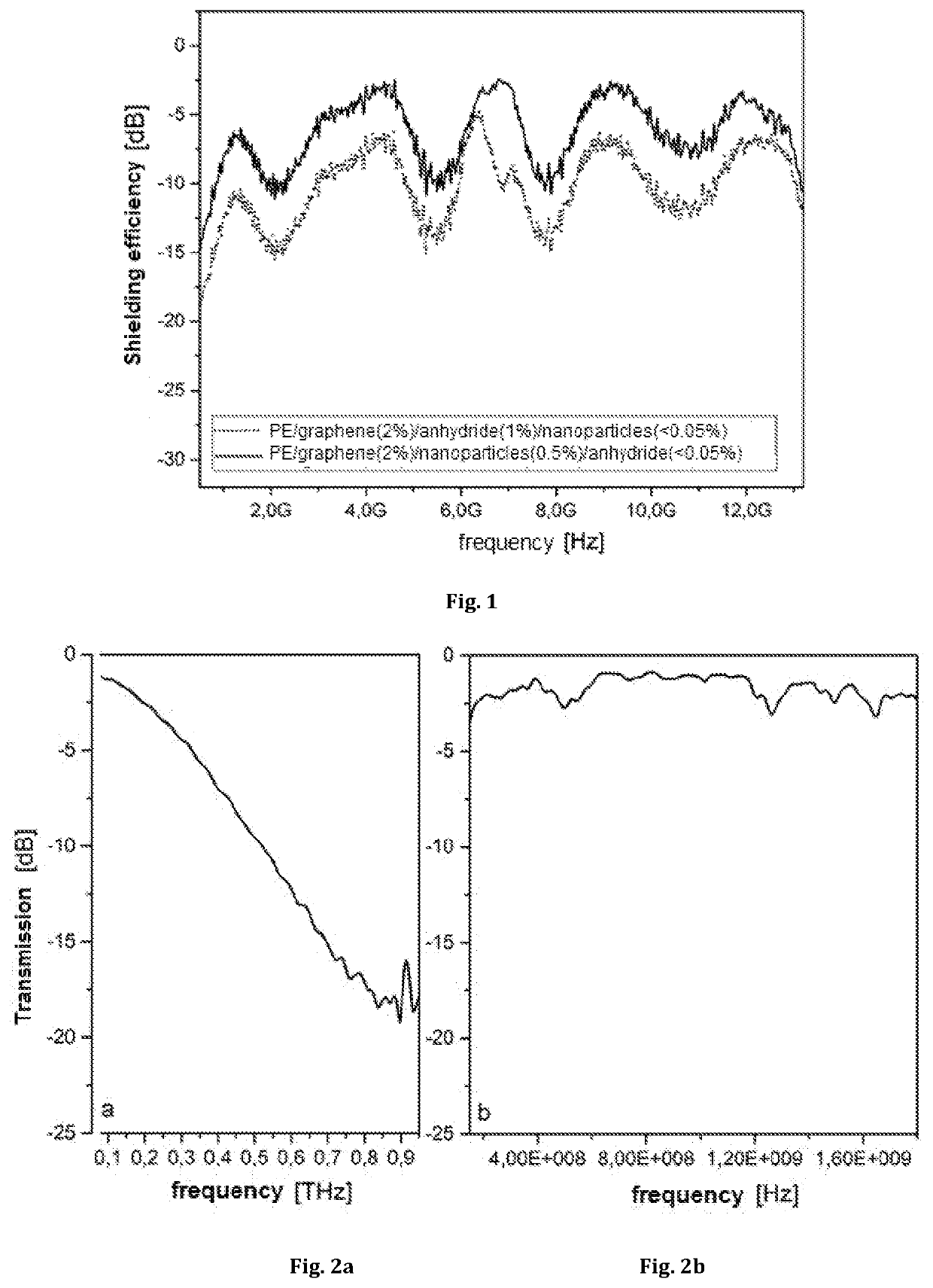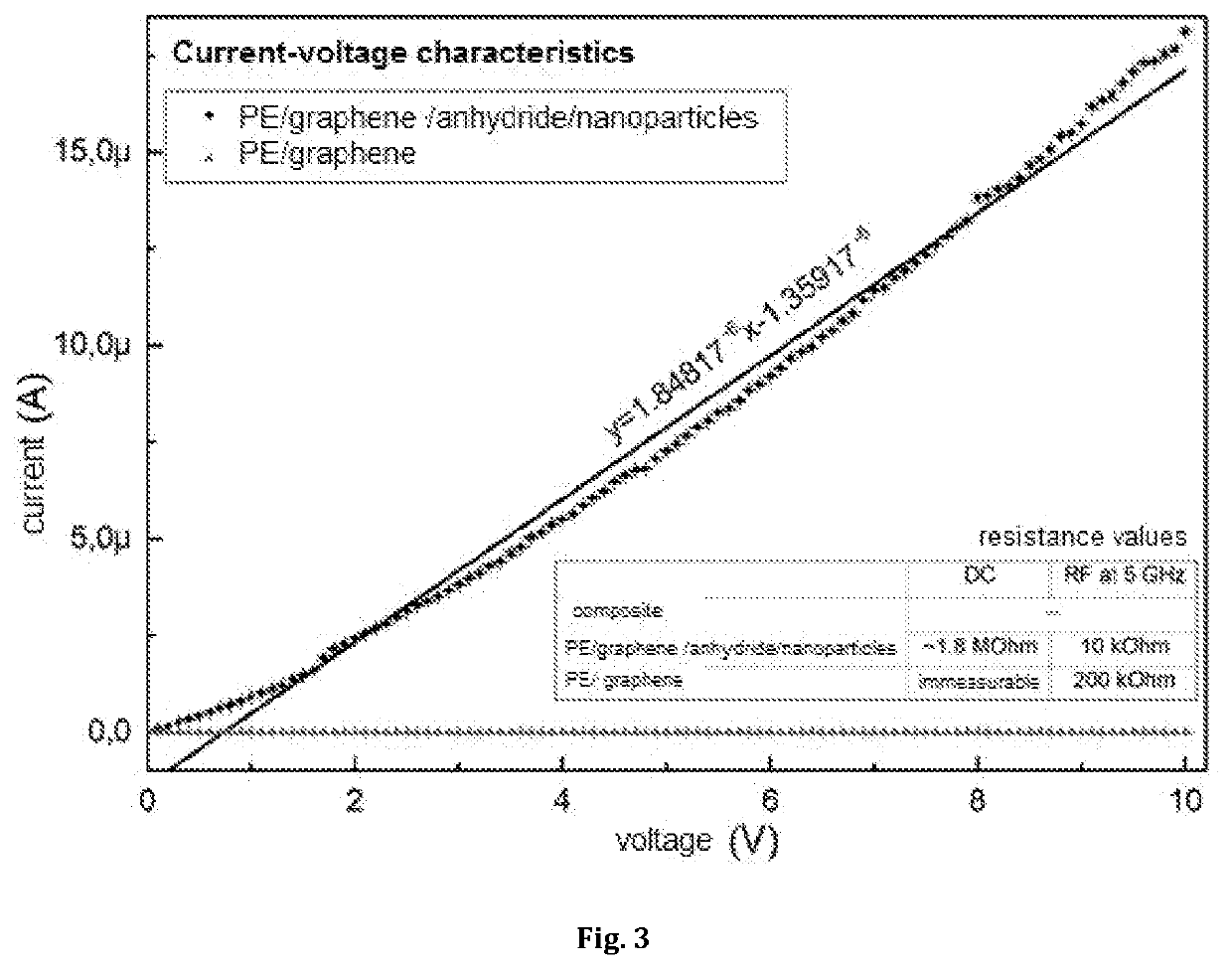Composite material for shielding electromagnetic radiation, raw material for additive manufacturing methods and a product comprising the composite material as well as a method of manufacturing the product
a technology of electromagnetic radiation and composite materials, which is applied in the direction of instruments, synthetic resin layered products, chemistry apparatus and processes, etc., can solve the problems of radiation having a negative impact on the operation of electronic devices and living organisms, including humans, and the inability to always use metal, etc., to achieve selective shielding efficiency and facilitate the transport of charge and heat
- Summary
- Abstract
- Description
- Claims
- Application Information
AI Technical Summary
Benefits of technology
Problems solved by technology
Method used
Image
Examples
example 1
[0049]Two samples were made. In both samples, a thermoplastic polymer, polyethylene (PE) was used as a polymer material, and a flake graphene (2 wt %) was used as a filler. The first sample contained also maleic anhydride (1 wt %) and a negligible amount of nanoparticles based on BaFe12O19 ferrites 0.05 wt %), while the other one—maleic anhydride (a negligible amount, i.e. 12O19). The materials were prepared using injection technology. Initially, a mixture of the above-mentioned components was prepared and they were mixed together mechanically, and then mixed again using a hot extruder (at a temperature above 220° C.) and thin plates having a thickness of 0.8-1 mm were formed using hot extrusion technique.
[0050]In the transmission mode, shielding efficiencies of the composites in the range of 0.1-12.5 GHz were measured (results on a logarithmic scale; the sign “-” in the graph means the weakening of the EM wave after passing through the material). Both materials had an efficiency ex...
example 2
[0052]A thermoplastic polymer from the group of polyesters-polyethylene terephthalate (PET) was used a polymer material, and a flake graphene (2 wt %) and minimum amounts of SrFei2O19 nanoparticles (<0.1 wt %) and maleic anhydride (<0.1 wt %) were used as a filler, and the material was prepared by injection technology. Graphene was added to the polymer when it was in a liquid state (i.e. above 265° C.) and hot mixed using an extruder and hot extrusion technique. The material was then hot pressed into a mould, the filling of which yielded a thin plate having a thickness of about 1.8 mm, and then cooled.
[0053]Degree of weakening (logarithmic scale) of electromagnetic radiation in the range of 0.1-0.95 THz (FIG. 2a) was measured. Negative values of transmission were indicative of how much radiation in decibels is weakened after passing through the material. The technology of time-resolved terahertz spectroscopy was used for the tests.
[0054]Transmission level (logarithmic scale) of elec...
example 3
[0057]A composite comprising polyethylene (PE), a filler in form of flake graphene (2 wt %), maleic anhydride (1 wt %) and a negligible amount (12O19 dielectric nanoparticles was obtained analogously to Example 1, producing samples in form of 1 mm thick plates. In a similar manner, samples of a comparative composite made of polyethylene and flake graphene (2 wt %) and negligible amounts of anhydride and nanoparticles (12O19 nanoparticles) is conductive over the entire measured range.
[0058]The above example illustrates that depending on the composition, the composite is conductive or non-conductive at different frequency ranges.
PUM
| Property | Measurement | Unit |
|---|---|---|
| Length | aaaaa | aaaaa |
| Nanoscale particle size | aaaaa | aaaaa |
| Nanoscale particle size | aaaaa | aaaaa |
Abstract
Description
Claims
Application Information
 Login to View More
Login to View More - R&D
- Intellectual Property
- Life Sciences
- Materials
- Tech Scout
- Unparalleled Data Quality
- Higher Quality Content
- 60% Fewer Hallucinations
Browse by: Latest US Patents, China's latest patents, Technical Efficacy Thesaurus, Application Domain, Technology Topic, Popular Technical Reports.
© 2025 PatSnap. All rights reserved.Legal|Privacy policy|Modern Slavery Act Transparency Statement|Sitemap|About US| Contact US: help@patsnap.com


